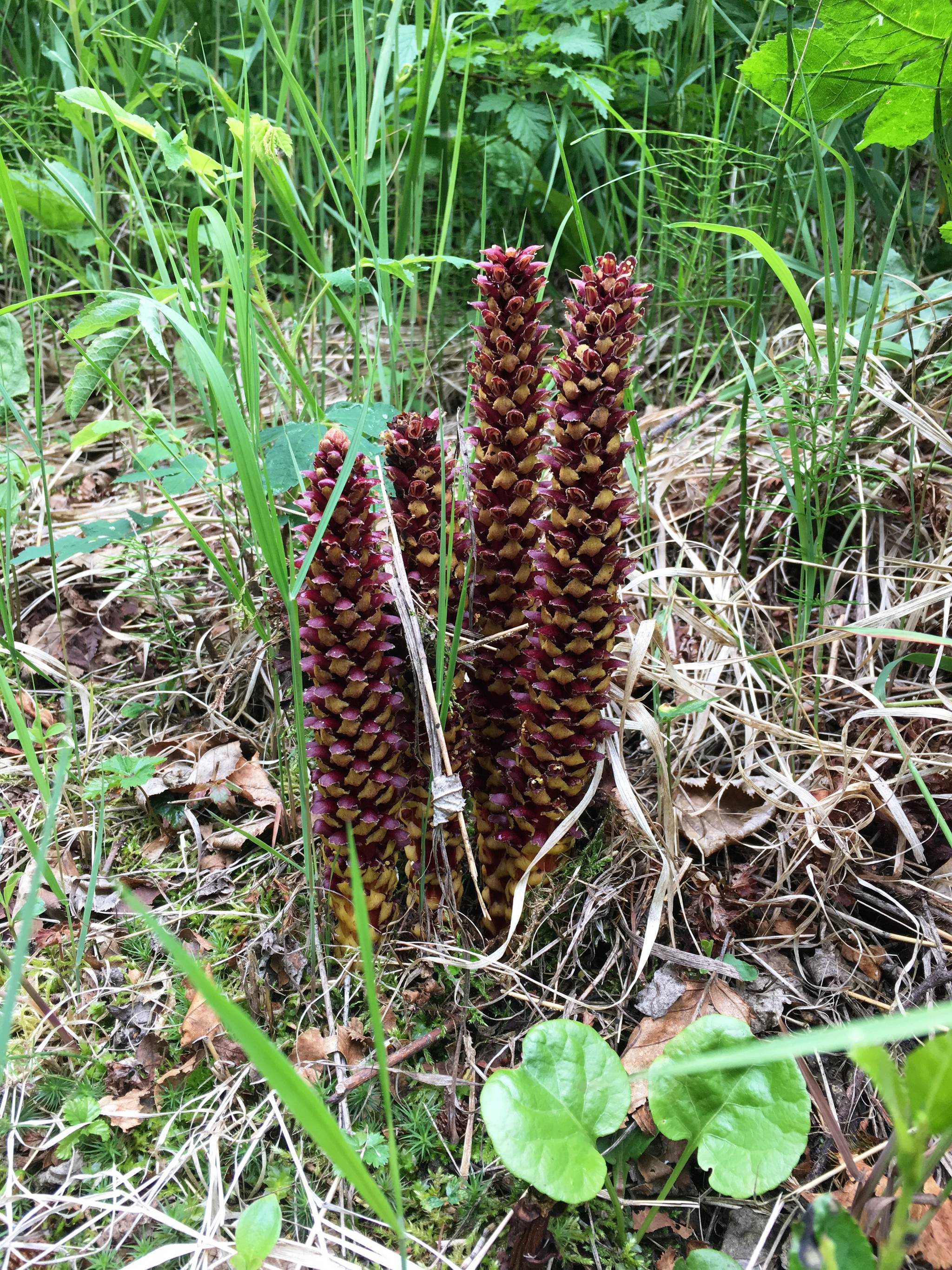In the 1992 movie “Medicine Man,” Sean Connery plays a scientist who discovers the cure for cancer in a rare ant species in the Amazon jungle. This is frequently used as a vague argument for why we should do our best to sustain global biodiversity – after all, you never know when an unknown species might actually remedy an incurable disease.
So imagine my surprise as I was researching the life history of a local plant, Boschniakia rossica, that it actually has anti-carcinogenic properties. This plant is easy to overlook because it’s very dark maroon to reddish brown, blending into the soil found beneath alders where it is typically found.
But, once you see it, you’ll wonder why you never noticed it before. This perennial grows 6-12 inches tall, with two to three stems per individual. It gets its common name, the Northern Groundcone, because it looks like a cylindrical pine cone that somebody stuck in the ground and because it is native to the northern latitudes of our northern hemisphere in an area on either side of the Bering Strait called Beringia. It gets its scientific name from A.K. Boschniaki, an amateur botanist who also happened to be Russian (rossica supposedly means “of Russia”). In Alaska, it grows north of the Brooks Range and as far south as the Prince of Wales Island.
Here on the Kenai Peninsula, it is typically found in acidic, wet to moist soils generally associated with Green Alder. The groundcone does not contain chlorophyll, so it parasitizes the roots of alder and, much less commonly, those of birch, willow, blueberry and Chamaedaphne (leatherleaf). Groundcones produce haustoria or specialized roots that penetrate the host’s tissue to draw water and nutrients from the phloem.
A tuber-like swelling or nodule can form where the roots of the groundcone and alder fuse, varying in color from whitish to dark brown. These nut-like nodules are bitter but edible raw or roasted. They are often dug-up by foraging bears. The flowered spikes that form the “groundcone” can produce up to 300,000 seeds. But if you’re interested in sampling the nuts, be aware that the groundcone does not necessarily mark where the nuts are growing − they may be further away along the alder roots.
The Northern Groundcone has a long history of being a medicine among northern cultures. In some First Nations and Native American tribes the whole plant is dried, ground, and used as a topical application, and sometimes smoked in a pipe. The Dena’ina called it qinaz’in, or “that which sticks up”. It is widely used in Chinese traditional medicine as a substitute for Cistanches Herba, a famous stamina tonic agent, and it reportedly prevents senility. Other traditional applications include cleansing and nourishing the kidneys in tonic form, curing impotence in men, strengthening the heart, easing constipation, alleviating skin rashes, increasing memory retention, and treating coughs. As it turns out, groundcones also contain chemical compounds that are attractive to cats and can induce the “catnip response”.
But it is the phenylpropranoid and iridoid glycosides in groundcones that have pharmaceutical companies interested. These compounds are secondary metabolites that exhibit anti-inflammatory, anti-lipid, anti-mutagenic and anti-oxidative effects. For example, laboratory studies show that iridoids inhibit skin cancer in rabbits and the early stages of liver cancer in rats. Google “Boschniakia rossica” and “pharmaceutical” to see how much research on this plant’s chemical properties have been generated since the 1990s.
So you (and drug companies) don’t have to go to the Amazon to search for the cure to cancer. The Northern Groundcone is common on the Kenai National Wildlife Refuge, first catching my attention on the Skilak Lookout Trail last summer. Until the snow flies, its flower stalks can still be found near the trails around the Refuge Headquarters on Ski Hill Road.
Dr. John Morton is the supervisory biologist at Kenai National Wildlife Refuge. Find more information about the Refuge at http://www.fws.gov/refuge/kenai/ or http://www.facebook.com/kenainationalwildliferefuge.

